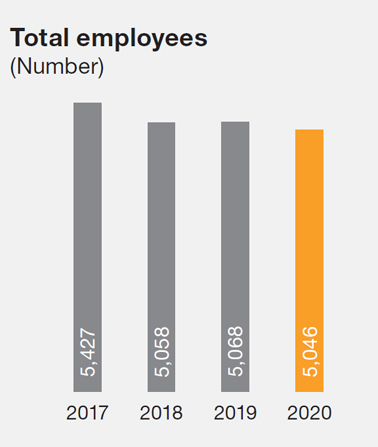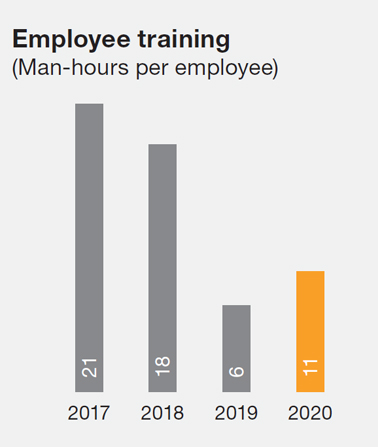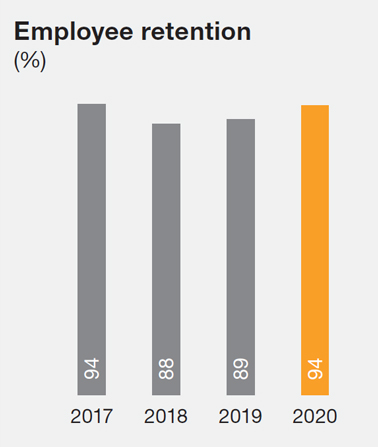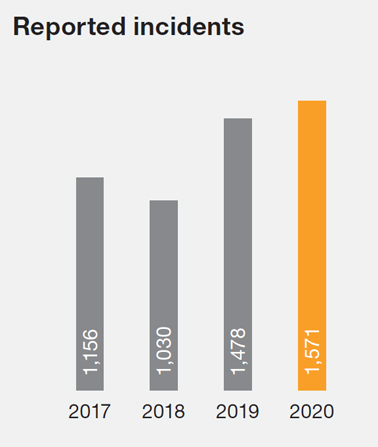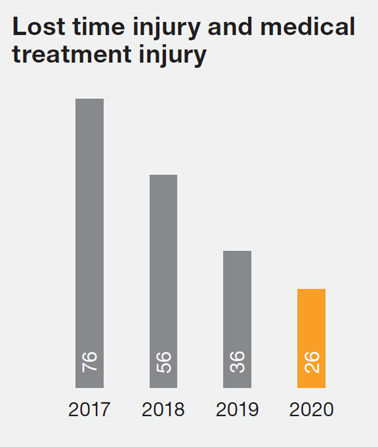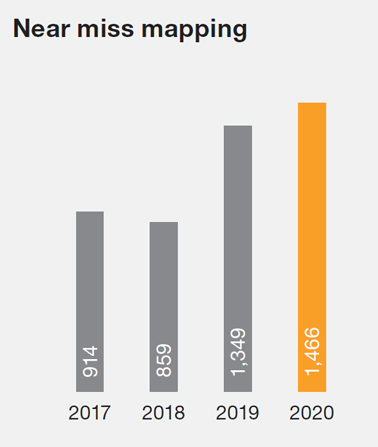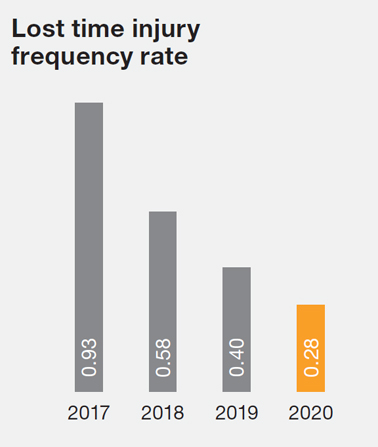Our HR management philosophy
revolves around empowering the
employees to make them more
productive, efficient and integral to
the organisation. We aim to strike a
balance between the achievement
of business goals and nurturing the
talent pool available to strengthen the
organisation’s competitive advantage.
We maintain a collaborative,
inclusive, non-discriminative and
safe work culture, and provide equal
opportunities to all employees. We
have a ‘Zero Tolerance’ policy towards
sexual harassment at the workplace
based on the applicable law. Our
Codes of Business Conduct lays down
acceptable professional behaviour
expected from our internal and
external stakeholders.
Employee benefits
Contribution to Superannuation Fund,
Provident Fund (PF), Employees’
State Insurance Corporation and
Labour Welfare Fund form our defined
contribution plan towards employee
benefits. Retirement benefits such
as gratuity, is considered as defined
benefit obligations; they are provided
based on actuarial valuation, using the
projected unit credit method. Postretirement
medical benefit is now
completely funded by beneficiaries.
Death and disability benefit is as per
the insurance policy. For most of the
employees, the Provident Fund is
managed by the Employees Provident
Fund Organisation (EPFO). Some
employees are part of the exempted PF
trust of Ambuja. Healthcare, disability,
invalidity coverage, life insurance,
and medical benefits are available
to employees. Superannuation is
not available to some categories of
Full-time employees (FTEs). All these
benefits are offered irrespective of
location. Women employees are
entitled to maternity leave as per
The Maternity Benefit (Amendment)
Act, 2017. An employee can avail
of maternity leave for a continuous
period of 26 weeks, or opt for two
13 week segments, divided between
the pre-natal and post-natal period
as per her convenience. This benefit
can be availed of up to a maximum of
two children. In 2020, seven women employees availed maternity leave; six
of them remained employed for the rest
of the year after resuming work, and
one is still on leave. A minimum of one
month notice is provided to employees
and their elected representatives prior
to the implementation of significant
operational changes that could
substantially affect them. This is
specified in the Industrial Relations
Act, 1947.
Employees who spend more than
a decade with the organisation are
felicitated with ‘Long Service Awards’.
Local minimum wage rules are
followed, and employees are paid
above the local minimum wages.
The ratio of the standard entry‑level
wage as compared to the local
minimum wage at significant locations
that include all our operating plants
is 1:1. Merit is the main parameter
for recruitment, but preference is
given to local hiring. We are an equal
opportunity employer providing equal
remuneration for women and men.
The ratio of the average basic and total
salary of women to men is 1.17:1 and
1.14:1, respectively management level
roles and 1:1 for the entry level average
total salary, considering all locations of
our operations.
We have recognised trade unions
affiliated to INTUC/AITUC/BMS,
representing blue collar employees at
different locations. Ambuja Cement
respects freedom of association
and allows its employees to join an
independent trade union. Out of our
total permanent workforce ~30%
employees are covered by collective
bargaining agreement.
Effective talent acquisition
We have in place campus hiring
programmes to recruit engineers and
management trainees to ensure a talent
pipeline that can be developed further
to accelerate our growth. During the
year, we recruited 142 new employees,
of which 9% are women.
Learning and development
We try to constantly improve employee
learning and development activities.
The training needs and performance
gaps identified during the appraisal
process serve as the basis for formulating training and development
programmes for employees.
The ACC ACL Leadership Academy
(AALA)—a joint academy of ACC and
Ambuja Cement, started in 2012—
and Techport (for technical trainings)
provide leadership as well as functional
trainings to employees for developing
capability and competence. Apart from
classroom and on-the-job trainings,
we also focus on virtual e-learning
trainings and webinars for a wider
coverage on different topics while
enabling employees to learn at their
own pace and place.
Being part of the LafargeHolcim
Group, we provide our employees
with international exposure through
short-term projects and long-term
assignments.
Initiatives in 2020
Owing to the pandemic, the learning
programmes in 2020 were designed
around the use of digital technology.
Learning became an essential tool
of employee engagement and we
partnered with various internal experts
and functional heads to deliver these.
The learning programmes were
delivered through a three-pronged
approach:
- A total of 702 training programmes
were conducted during 2020
including physical and virtual
sessions on functional skill
development, soft skill development
and other modules relevant
for management and personal
development
- Other organisation-specific learning
programmes driven by the function
heads
These sessions utilised the online
meeting platform, along with the
in-house learning experience platform,
Super Assisted Intelligent Learning
(SAIL). SAIL is an application which
works not only as a repository for
programmes conducted, but also
for content creation, curation and
e-learning.
As per the business and training need
analysis, we are running certification
programme, role-based programmes
and expert development initiatives:
Plant-specific programmes
We run some specific programmes
to achieve consistent operations,
standard maintenance within the
plant and across the plants between
operators, engineers and technicians
in order to achieve sustainable
high performance.
Programme objective
- Consistently achieve operational
and maintenance targets by having
reliable operators, engineers and
managers who perform well and in
a safe manner
- Achieve sustainable high
performance in our plants
- Standardised maintenance
operation within LafargeHolcim
Group standards on operation
and safety
The following programmes were
initiated:
- Control room operator certification
- Walk-by inspector certification
- Process engineer certification
- Preventive maintenance engineer
certification
- Expert development initiative on
critical skills
- Leveraging technology—remote
troubleshooting and training
Talent management
Our focus on nurturing talent with care
and a fair remuneration policy has
helped in developing a strong sense
of ownership among our employees.
Structured talent reviews, supported
with Individual Development Plans
(IDPs) and cross-functional and
cross-location assignments have
resulted in a healthy talent intake.
We introduced a new performance
structure that defines Profit & Loss
Accountability.
We initiate continuous dialogues
with our employees for their
feedback on deliverables, resulting
in better performance management.
Our dynamic objective setting, which
periodically translates the business
objectives into team and individual
contributions, helps in driving better
employee productivity. Together
with our periodic inputs that incite
merit increase, and bonus benefits,
we are helping strengthen our
employee output.
People for Tomorrow is our
LafargeHolcim Group initiative to
identify leading talent at our plants,
close competency gaps and manage
succession. It helps to ensure that we
have the right people, in the right role,
with the right competencies, at our
industrial sites.
Shaping behaviour at work
We follow the Kirk Patrick evaluation
methodology for findings the results
of our training programmes, which
enables us to assess and shape
employee behaviour along three
levels— Level 1: Reaction, Level 2:
Learning, Level 3: Behaviour change,
and Level 4: Results of the training
(applied for few trainings).
Level 1 and Level 2 behaviour were
assessed through knowledge‑based
programmes, largely in the large
webinar category. For Level 3
assessment, action learning projects
were conducted to assess whether
employees can convert their learning
into action. Level 3 evaluation was
initiated for a host of programmes,
including successor development
programme, health and safety and
technical trainings. The method
helped us measure how a training has
influenced behaviour and how this
is applied on-the-job. We used this
method to assess dealers following
the completion of the ‘New Dealer
Appointment’ training.
Training programmes imparted in
2020
(Physical and Online)
702
Developing a leadership pipeline
We invest proactively in training
initiatives for leadership development
to create a robust leadership pipeline
to drive the long-term growth objective
of Ambuja Cement. We focused our
leadership development initiatives
during the year around our Strategy
2022. We directed our leadership
programmes on health, cash and cost
to combat the change in the business
environment. The focus was on the
following:
- Build own resilience in managing
the pandemic: Our focus areas
were working with emotional
intelligence, managing team
motivation and managing dealer
relationships during the lockdown
- Build resilience as a team:
Grooming dealers, appointing new
dealers, honing cross-functional
skills, working and developing
stronger customer relations were
part of this initiative
- Build resilience as a business:
Negotiating with cash and cost,
lean thinking, reducing cost of
power and fuel, working with net
zero mandates were some of the
topics discussed
- Others: First time managerial skill
development initiative was also
taken up as an extension of the
leadership development programme
Succession planning
Key senior positions at Ambuja
Cement are now being increasingly
filled internally. Our Sustainable
Talent for Enhanced Performance (STEP) programme duly complements
our talent management model
for succession planning of senior
management.
We have created a structured talent
review and succession planning
process that assesses people on
defined matrices and plots them in a
nine-box performance and potential
matrix. Based on the outcome of
the matrix, the high-potential (HiPo)
candidates are assessed on their
preparedness and readiness to take on
higher-level roles.
The identified successors undergo
customised development programmes
to prepare them for the higher-level
roles in the organisation.
We have a pool of ready successors
who will drive our growth strategy over
the next three to five years.
Industrial relations
At Ambuja Cement, we believe that the
interests of our employees and those
of the Company are inseparable. With
this principle in mind, we engage with
our employee unions. On almost all the
occasions, a negotiated settlement/
understanding is reached in a
win-win manner.
Occupational health and safety
Health and safety (H&S) remains one
of our core focus areas and we have
worked to make health and safety
improvement a way of life at Ambuja
Cement. The year 2020 was the final
year of our three-year H&S Strategy in
order to take our performance in this
function to a new level. We had put
in place the right systems where they were needed and focused on better
implementation rather than introducing
new initiatives. Our H&S improvement
deliverables for 2020 were built
around the theme, ‘Consolidate and
Strengthen As Is’.
Despite the onset of the pandemic,
we were able to achieve a year of zero
onsite and offsite fatality with 30.3%
reduction in LTIFR. Road injuries also
reduced by 56.5%.
Key challenges to H&S in 2020
The biggest challenge to operations
in 2020 was the pandemic. We moved
with speed and learnt to operate in a
COVID-19 environment, where we had
to take this as one of the risks without
losing focus.
Some of our key focus areas are the
following:
- Institutionalising operational
discipline on the frontline, especially
with regard to compliance of rules
that govern safe behaviours
- Ensuring a robust permit to work
system across locations
- Implementing our fatality elimination
controls on the ground
- Maintaining our medical emergency
response capability at the required
level continuously, especially at
remote locations
- Ensuring acceptable driving
behaviours and compliance with
minimum vehicle specifications in
our logistics chain to reduce both
incidents and injuries
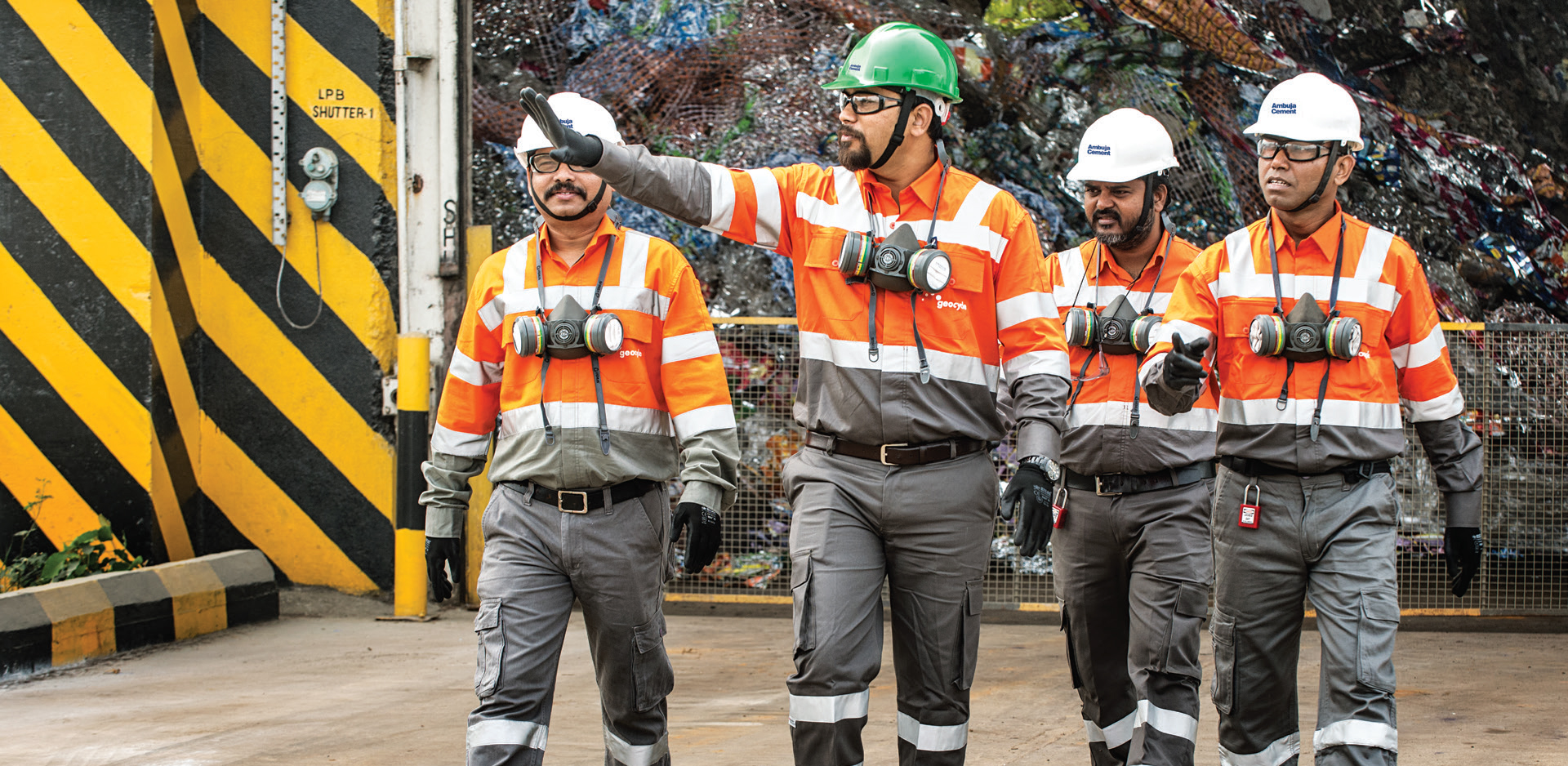
We focused on five pillars in our H&S process
| Onsite fatality
elimination |
Zero harm
culture |
Systems and
processes |
Control of
health risks |
Road fatality
reduction |
- Zero tolerance for
non-compliance
- Focus on leading
indicators
- Minimise repeat
incidents
- Strengthening job
risk management
– HIRA, PTW and
MOC
- Implement mobile
FEC
- Establish DSCQP
baseline and
implement Group
process
- Ensure silo
cleaning
capability
and process
compliance
|
- Greater leadership
visibility in the
field – Boots on
Ground
- Sustain ‘We Care’
through focus on
‘two minutes and
three behaviours’
and behaviourbased
safety
- H&S leadership
workshop for
cluster and unit
top leadership
- Step up H&S
competencies at
all levels
- Improve incident
investigation
capability and
capacity
- HSMS
implementation –
Marwar Mundwa
and underground
mine in coal block
|
- Digital
transformation –
integration with
iCare 2.0
- Strengthen
assurance around
permit to work
system, HSIP
implementation at
unit level, action
closure for crossand
intra-plant
audits
- Raise process
safety
management
awareness and
competency –
pilot programme
for Ambuja
Cement
- Pre-start up
safety review
implementation
- Review and
revitalise railway
safety
- Emergency
response
|
- Establish in-house
baseline and
complete survey
for remaining units
- Reduce dust
exposure through
control of fugitive
emissions, review
of efficacy of
existing hierarchy
of controls at
packing plants
and better
housekeeping
- Noise-specific
control plan
- Health
surveillance
digitisation
- Reduction of
manual handling
at warehouses
|
- 95% controlled
fleet through
monitored iVMS
- 90% controlled
fleet drivers
trained in Incab
- Effective
implementation
of rewards and
recognition and
consequence
management
- Minimum vehicle
specification
|
iVMS - In-Vehicle Monitoring System, HIRA - Hazard Identification and Risk Assessment, PTW - Permit To Work, MOC - Management of Change,
FEC - Fatality Elimination Control, DSCQP - Design Safety and Construction Quality Programme, HSMS - Health & Safety Management System,
HSIP - Health & Safety Improvement Plan
This plan was supported throughout
the year by:
- Compliance through visible frontline
leadership – Boots on Ground
- Strong mitigating measures against
COVID-19, including medical
emergency response
- Monthly performance monitoring at
unit and corporate level
- Remote audits and
self assessments on HSMS
implementation at all units
- Campaigns/waves on:
- - Housekeeping
- - Permit to work
- - Machine guarding
- - Working at height
- Sharing and replication of best
practices
- Timely closure of actions from
audits, process safety related
self-assessments and structural
inspections
Achievements in 2020
Our cohesive efforts across all sites
on operational discipline, systems and
processes, learning from incidents, and
more visible leadership presence in the
field (Boots on Ground) have helped
deliver stupendous results in 2020.
We even registered a 2% increase in
man-hours from 2019.
Highlights of our onsite H&S
performance:
- Completed the year with zero harm
in six units Surat (Gujarat), Dadri
(Uttar Pradesh), Kochi (Kerala),
Roorkee (Uttarakhand), Dirk India
Private Limited (DIPL) and coal
block
- Achieved more than six years of
Lost Time Injury (LTI) free in two
units (Surat and Dadri)
- Recorded a year of LTI free in 13
other manufacturing units
- Reported 14.28% reduction in total
onsite recordable injuries compared
with 2019
Road safety
We have also progressed well on road
safety, despite the impact of COVID-19,
especially on counselling drivers and
practical trainings. Key achievements
during the year in this space are as
follows:
- Reported 8.5% drop in logistics
related incidents
- Completed 1,891 Incab
assessments (practical on the
road) covering truck drivers and
company-owned four wheeler
drivers
- Installed 853 iVMS and 567 voice
boxes in controlled fleet trucks
for better coverage of driving
behaviours
- Achieved 10% increase in share
of safe km by two wheelers in
marketing vis-à-vis 2019
Man-hours of safety training
imparted in 2020
28,650
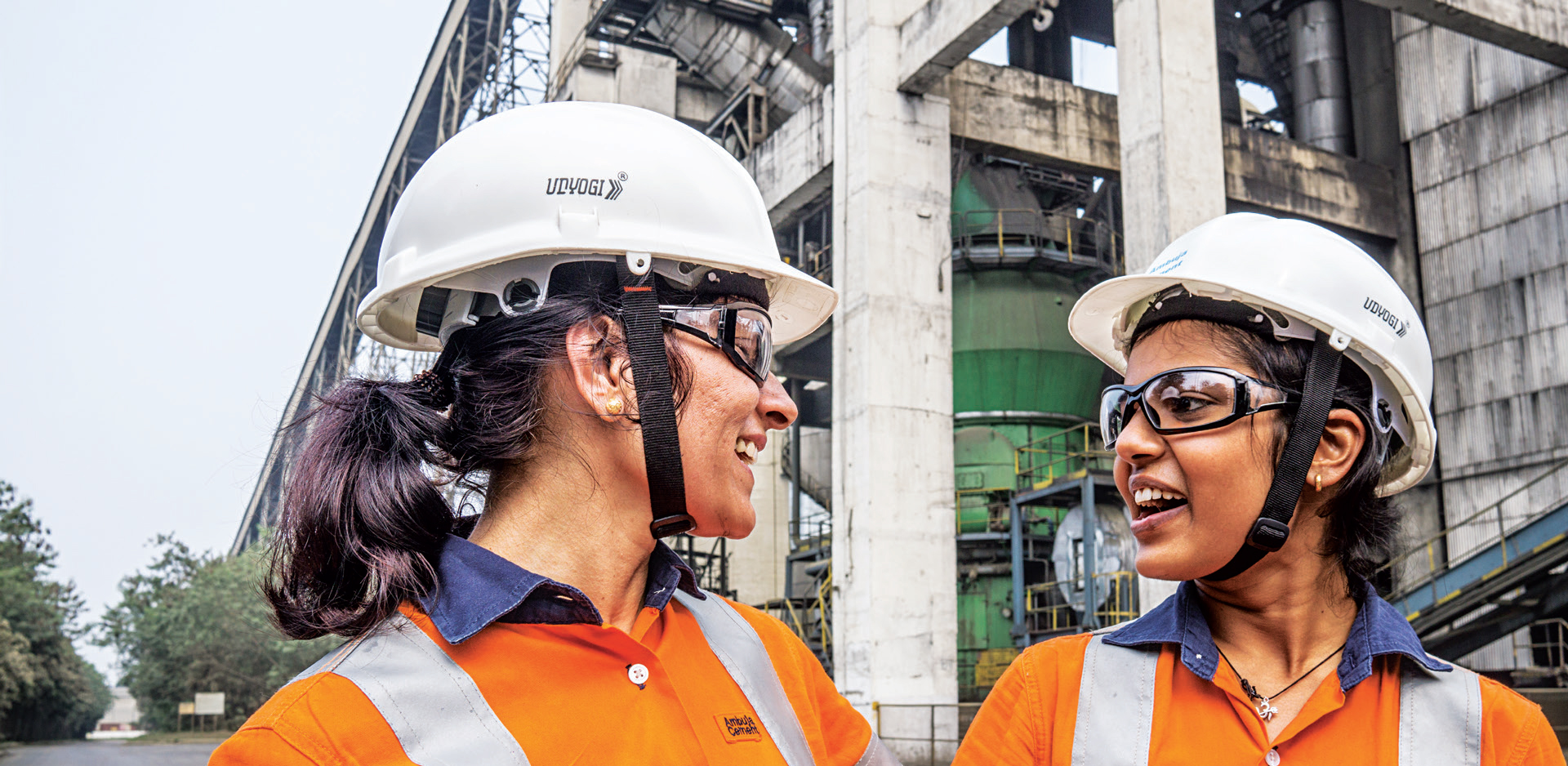
Conflict management
Our operating mining sites are not
located adjacent to indigenous
peoples' territories. We address issues
revolving around local communities
(land acquisition and dust emission)
through a consultative process and
purchase land through negotiations.
There were no strikes or lockouts at our
mines during the reporting period.
Protecting human rights
We have stipulated our human rights
policy in our Code of Conduct and
Business Ethics applicable to all
employees, vendors and suppliers.
We also stringently follow the
LafargeHolcim Group’s Directive on
Human Rights. Our commitment to
human rights is also reinforced by our
Group’s participation in the UN Global
Compact (UNGC), support for the Code
of Business Conduct for Suppliers, and
our CSR Policy.
A proactive comprehensive risk
assessment is undertaken across our
operations through Site Specific Impact
Assessments (SSIA), wherein each
operational site is assessed at least
once in a three-year cycle for potential
human rights risks and opportunities.
During 2020, SSIA could not be
conducted on site to avoid exposure
of employees and other stakeholders
with potential health hazards. Besides,
we continued to review the process of
the human rights compliance of our
plants, joint ventures and subsidiaries
remotely. Our JVs and subsidiaries
provided us with a declaration of
their compliance to our policies and
regulations on human rights protection.
We ensured that our contractual labour
is covered by the Contract Labour
(Regulation and Abolition) Act, along
with mechanisms to monitor the
compliance and report any violations.
We have a Supplier Code of Conduct
(SCC) that covers various human rights
aspects. We continued to sensitise our
employees and security personnel on
human rights and possible
associated issues.
The total number of incidents,
complaints or grievances of human
rights violations, along with the
backlog of earlier incidents is zero. No
complaints were received, nor are any
pending cases of child labour, forced/
involuntary labour, sexual harassment
and discriminatory employment.
Complaints received by
Ambuja Cement for violation
of human rights
ZERO




